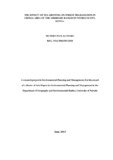| dc.description.abstract | Tea growing in Kenya has been expanding into the Aberdare forest where the physical condition for its growth is good and economic returns are profitable. Subsequently, the expansion has contributed to forest loss due to fuel demand in the tea processing factories. Therefore, this study was aimed at addressing the effect of tea growing on forest degradation in Chinga area of the Aberdares Ranges in Nyeri County. The study ignored other sources of forest degradation such as forest fires, pollution and wind. The study covers an area of approximately 36km2 where majority of the residents are original inhabitants, only few migrated from settled forest areas when these settlements were banned by the government in the mid 1980s.The main occupation of these residents is cultivation of tea.
The broad objective for this study was: To establish whether there is a link between increased tea acreage and forest degradation and whether the increased demand of wood fuel has a relationship with loss of forest cover. This research was based in Chinga location whose population is estimated at 15000.The research used a case study approach where ten regions were selected; nine of these regions contributed 24 respondents each while the tenth region had 30 respondents. This amounted to 246 respondents that were randomly selected out of an approximate 1500 tea farmers. Determination of relationship between attributes was achieved through cross tabulations and correlations using SPSS package, both the chi square test and simple regression analysis were used to determine the relationship between forest cover change and tea expansion. Regression analysis was also used to determine the effect of the use of wood fuel and forest cover change.
The key findings were as follows: Expansion of tea growing areas in Chinga area has a negative relationship with forest cover (plate 1, and plate 2), the resulting increased tea acreage has led to clearing of more land so as to cultivate tea. More forest trees have continuously been lost as a result. Increased use of wood fuel has led to significant forest degradation. This is contrary to an earlier feeling that the relationship would be negative. This study sought to find out whether there is a link between increased Tea expansion and losses of forest cover and if use of wood fuel has had an impact on the forest cover. The study had the following two conclusions: that tea development has had a significant effect on forest cover; this study inferred an
increase in tea acreage and a reduction of forest cover. At this rate of tea expansion, we may not have any forests remaining in the farmlands in the future. Extraction of wood fuel has impacted negatively on forest cover.
There has been over reliance on wood fuel in Chinga Tea Factory to an extent that for every one ton increase in wood fuel usage, 0.695 acres of forest land is lost at a significant level of 0.05. This study inferred a reduction of 0.695 acres of forest land as being lost for every ton of wood fuel used. On the other hand, for every extra acre planted with tea, 0.889 acres of forest was lost. Both expansion of tea and use of wood fuel have negative effects on forest cover. The tea expansion has led to the cutting of small bushes to pave way for tea cultivation, this increase in tea production has also created demand for more wood to process the increasing tea output by Chinga Tea Factory. The result has been increased illegal logging in order to sustain this demand. There is no realistic afforestation program in Chinga area as large patches of forest clearing are visible (plate 1, page 50) and (plate 2, page 49).This study proposed the following research hypothesis: there is no significant relationship between expansion of tea and forest degradation in Chinga area. The study chose the ten year period between 1995 and 2005 because nearly ten years before in 1986, a presidential order that started the Nyayo tea zones was given, It was aimed at stopping forest encroachment. Such unchecked increase in wood fuel use could deplete forest trees in ten years.
The recommendations made were: that a vegetated buffer stripe should be planted along the streams and rivers so as to encourage growing of trees that do not consume a lot of water along the water bodies; Chinga Tea Factory should be encouraged to plant its own trees to improve its own wood fuel base; the Kenya Forest Service should do reforestation to the identified forest patches so as to restore the earlier state of forest. | en |

